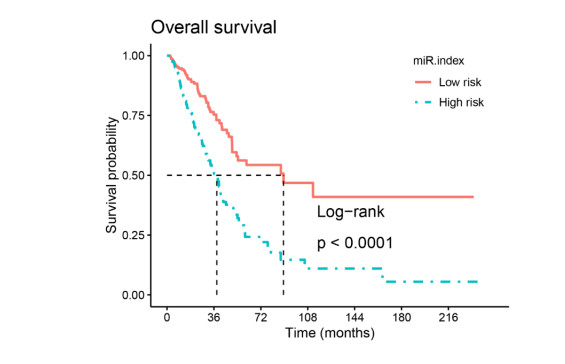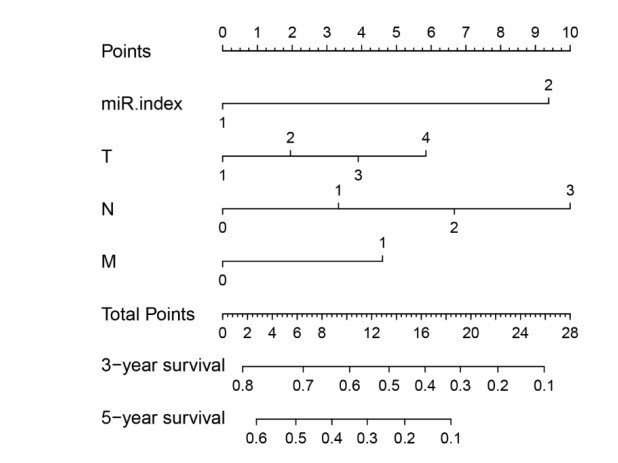|
[1]
|
F. Bray, J. Ferlay, I. Soerjomataram, R. L. Siegel, L. A. Torre, A. Jemal, Global cancer statistics 2018: GLOBOCAN estimates of incidence and mortality worldwide for 36 cancers in 185 countries, Ca-Cancer J. Clin., 68 (2018), 394-424. doi: 10.3322/caac.21492

|
|
[2]
|
C. Allemani, T. Matsuda, V. Di Carlo, R. Harewood, M. Matz, M. Nikšić, et al., Global surveillance of trends in cancer survival 2000-14 (CONCORD-3): Analysis of individual records for 37 513 025 patients diagnosed with one of 18 cancers from 322 population-based registries in 71 countries, Lancet, 391 (2018), 1023-1075. doi: 10.1016/S0140-6736(17)33326-3

|
|
[3]
|
E. Zlotorynski, Insights into the kinetics of microRNA biogenesis and turnover, Nat. Rev. Mol. Cell. Biol., 20 (2019), 511.
|
|
[4]
|
N. Treiber, T. Treiber, G. Meister, Regulation of microRNA biogenesis and its crosstalk with other cellular pathways, Nat. Rev. Mol. Cell Biol., 20 (2019), 5-20.
|
|
[5]
|
D. P. Bartel, MicroRNAs: Genomics, biogenesis, mechanism, and function, Cell, 116 (2004), 281-297. doi: 10.1016/S0092-8674(04)00045-5

|
|
[6]
|
J. Winter, S. Jung, S. Keller, R. I. Gregory, S. Diederichs, Many roads to maturity: MicroRNA biogenesis pathways and their regulation, Nat. Cell Biol., 11 (2009), 228-234. doi: 10.1038/ncb0309-228

|
|
[7]
|
R. Rupaimoole, F. J. Slack, MicroRNA therapeutics: Towards a new era for the management of cancer and other diseases, Nat. Rev. Drug Discov., 16 (2017), 203-222. doi: 10.1038/nrd.2016.246

|
|
[8]
|
G. A. Calin, C. M. Croce, MicroRNA signatures in human cancers, Nat. Rev. Cancer, 6 (2006), 857-866. doi: 10.1038/nrc1997

|
|
[9]
|
D. A. Clump, C. R. Pickering, H. D. Skinner, Predicting outcome in head and neck cancer: MiRNAs with potentially big effects, Clin. Cancer Res., 25 (2019), 1441-1442. doi: 10.1158/1078-0432.CCR-18-3078

|
|
[10]
|
J. Hess, K. Unger, C. Maihoefer, L. Schuttrumpf, L. Wintergerst, T. Heider, et al., A Five-MicroRNA signature predicts survival and disease control of patients with head and neck cancer negative for HPV infection, Clin. Cancer Res., 25 (2019), 1505-1516. doi: 10.1158/1078-0432.CCR-18-0776

|
|
[11]
|
P. Ulivi, E. Petracci, G. Marisi, S. Baglivo, R. Chiari, M. Billi, et al., Prognostic role of circulating miRNAs in early-stage non-small cell lung cancer, J. Clin. Med., 8 (2019), 131. doi: 10.3390/jcm8020131

|
|
[12]
|
Y. Zhang, J. A. Roth, H. Yu, Y. Ye, K. Xie, H. Zhao, et al., A 5-microRNA signature identified from serum microRNA profiling predicts survival in patients with advanced stage non-small cell lung cancer, Carcinog., 40 (2019), 643-650. doi: 10.1093/carcin/bgy132

|
|
[13]
|
H. Yan, S. Xin, J. Ma, H. Wang, H. Zhang, J. Liu, A three microRNA-based prognostic signature for small cell lung cancer overall survival, J. Cell. Biochem., 120 (2018), 8723-8730.
|
|
[14]
|
X. Li, Z. An, P. Li, H. Liu, A prognostic model for lung adenocarcinoma patient survival with a focus on four miRNAs, Oncol. Lett., 14 (2017), 2991-2995. doi: 10.3892/ol.2017.6481

|
|
[15]
|
Y. Lin, Y. Lv, R. Liang, C. Yuan, J. Zhang, D. He, et al., Four-miRNA signature as a prognostic tool for lung adenocarcinoma, Onco. Targets Ther., 11 (2018), 29-36.
|
|
[16]
|
S. S. Yerukala, S. Y. Ho, Identifying the miRNA signature associated with survival time in patients with lung adenocarcinoma using miRNA expression profiles, Sci. Rep., 7 (2017), 7507. doi: 10.1038/s41598-017-07739-y

|
|
[17]
|
M. Raponi, L. Dossey, T. Jatkoe, X. Wu, G. Chen, H. Fan, et al., MicroRNA classifiers for predicting prognosis of squamous cell lung cancer, Cancer Res., 69 (2009), 5776-5783. doi: 10.1158/0008-5472.CAN-09-0587

|
|
[18]
|
R. Bajaj, D. Doval, R. Tripathi, T. Sridhar, A. Korlimarla, K. D. Choudhury, et al., Prognostic role of microRNA 182 and microRNA 18a in locally advanced triple negative breast cancer, Ann. Oncol., 30 (2019), 19.
|
|
[19]
|
H. Li, J. Liu, J. Chen, H. Wang, L. Yang, F. Chen, et al., A serum microRNA signature predicts trastuzumab benefit in HER2-positive metastatic breast cancer patients, Nat. Commun., 9 (2018), 1614. doi: 10.1038/s41467-018-03537-w

|
|
[20]
|
S. Di Cosimo, V. Appierto, S. Pizzamiglio, P. Tiberio, M. V. Iorio, F. Hilbers, et al., Plasma miRNA levels for predicting therapeutic response to neoadjuvant treatment in HER2-positive breast cancer: Results from the NeoALTTO trial, Clin. Cancer Res., 25 (2019), 3887-3895. doi: 10.1158/1078-0432.CCR-18-2507

|
|
[21]
|
S. Shiino, J. Matsuzaki, A. Shimomura, J. Kawauchi, S. Takizawa, H. Sakamoto, et al., Serum miRNA-based prediction of axillary lymph node metastasis in breast cancer, Clin. Cancer Res., 25 (2019), 1817-1827. doi: 10.1158/1078-0432.CCR-18-1414

|
|
[22]
|
L. Yu, D. Wu, H. Gao, J. J. Balic, A. Tsykin, T. S. Han, et al., Clinical utility of a STAT3-Regulated miRNA-200 family signature with prognostic potential in early gastric cancer, Clin. Cancer Res., 24 (2018), 1459-1472. doi: 10.1158/1078-0432.CCR-17-2485

|
|
[23]
|
P. Wang, W. Li, B. Zhai, X. Jiang, H. Jiang, C. Zhang, et al., Integrating high-throughput microRNA and mRNA expression data to identify risk mRNA signature for pancreatic cancer prognosis, J. Cell. Biochem., 121 (2020), 3090-3098. doi: 10.1002/jcb.29576

|
|
[24]
|
X. Zhang, H. Zhang, B. Shen, X. F. Sun, Novel MicroRNA biomarkers for colorectal cancer early diagnosis and 5-Fluorouracil chemotherapy resistance but not prognosis: A study from databases to AI-Assisted verifications, Cancers (Basel), 12 (2020), 341. doi: 10.3390/cancers12020341

|
|
[25]
|
R. Kandimalla, F. Gao, T. Matsuyama, T. Ishikawa, H. Uetake, N. Takahashi, et al., Genome-wide discovery and identification of a novel miRNA signature for recurrence prediction in stage II and III colorectal cancer, Clin. Cancer Res., 24 (2018), 3867-3877. doi: 10.1158/1078-0432.CCR-17-3236

|
|
[26]
|
L. Schmidt, J. Fredsoe, H. Kristensen, S. H. Strand, A. Rasmussen, S. Hoyer, et al., Training and validation of a novel 4-miRNA ratio model (MiCaP) for prediction of postoperative outcome in prostate cancer patients, Ann. Oncol., 29 (2018), 2003-2009. doi: 10.1093/annonc/mdy243

|
|
[27]
|
J. S. Nahand, S. Taghizadeh-Boroujeni, M. Karimzadeh, S. Borran, M. H. Pourhanifeh, M. Moghoofei, et al., MicroRNAs: New prognostic, diagnostic, and therapeutic biomarkers in cervical cancer, J. Cell. Physiol., 234 (2019), 17064-17099. doi: 10.1002/jcp.28457

|
|
[28]
|
B. Liang, Y. Li, T. Wang, A three miRNAs signature predicts survival in cervical cancer using bioinformatics analysis, Sci. Rep., 7 (2017), 5624. doi: 10.1038/s41598-017-18338-2

|
|
[29]
|
X. H. Yin, Y. H. Jin, Y. Cao, Y. Wong, H. Weng, C. Sun, et al., Development of a 21-miRNA signature associated with the prognosis of patients with bladder cancer, Front. Oncol., 9 (2019), 729. doi: 10.3389/fonc.2019.00729

|
|
[30]
|
M. E. Ritchie, B. Phipson, Di Wu, Y. Hu, C. W. Law, W. Shi, et al., {Limma} powers differential expression analyses for {RNA}-sequencing and microarray studies, Nucleic. Acids. Res., 43 (2015), 47. doi: 10.1093/nar/gkv007

|
|
[31]
|
R Core Team, R: A Language and Environment for Statistical Computing, Vienna, Austria, 2020.
|
|
[32]
|
G. Yang, Y. Zhang, J. Yang, A Five-microRNA signature as prognostic biomarker in colorectal cancer by bioinformatics analysis, Front. Oncol., 9 (2019), 1207. doi: 10.3389/fonc.2019.01207

|
|
[33]
|
Y. Luo, C. Zhang, F. Tang, J. Zhao, C. Shen, C. Wang, et al., Bioinformatics identification of potentially involved microRNAs in Tibetan with gastric cancer based on microRNA profiling, Cancer Cell Int., 15 (2015), 115. doi: 10.1186/s12935-015-0266-1

|
|
[34]
|
Y. Lv, J. Duanmu, X. Fu, T. Li, Q. Jiang, Identifying a new microRNA signature as a prognostic biomarker in colon cancer, PLoS. One, 15 (2020), 228575.
|
|
[35]
|
Therneau, M. Terry, A Package for Survival Analysis in R, 2020.
|
|
[36]
|
A. Kassambara, M. Kosinski, P. Biecek, Survminer: Drawing Survival Curves using 'ggplot2', 2019.
|
|
[37]
|
F. E. H. Jr, Rms: Regression Modeling Strategies, 2019.
|

















 DownLoad:
DownLoad: